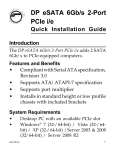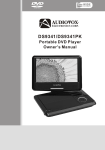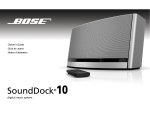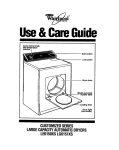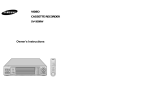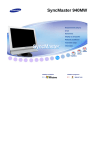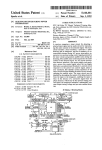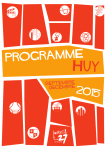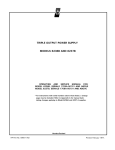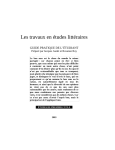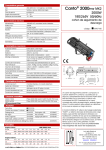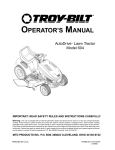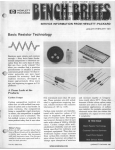Download FRACTIONAL N SIMPLIFIES FREQUENCY SYNTHESIS
Transcript
SERVICE INFORMATION FROM HEWLETT-PACKARD MAY-AUGUST 1977 FRACTIONAL N SIMPLIFIES FREQUENCY SYNTHESIS by Kenneth Jessen, HP Loveland Division INTRODUCTION C c Hewlett-Packardis introducing several new instruments that use a new frequency synthesis technique known as fractional N. This new technique overcomes many of the limitations of the traditional divide-by-N loop. Any given divide-by-N loop can only produce frequencies which are integral multiples of the reference frequency. The 33308 Automatic Synthesizer, for example, uses four divide-by-N loops of different frequency rangesto producean overall range fr6m 0.1 Hz to 13,000,999.9 Hz. The first, second and third digits of the output frequency are controlled by the first divide-by-N loop. The fourth and fifth digits are controlled by the second divide-by-N loop; the sixth and seventh digits are controlled by the third loop and the remaining two digits by the fourth loop. (Summation loops are also required to sum the outputs of the divide-by-N loops but they are ignored to simplify this discussion.) The new HP3335A Synthesizer/Level Generator can produce frequencies from 200.00 Hz to 80,099,999,999 Hz using only two loops. One loop is a common divide-by-N loop producing 39 MHz to 79 MHz in 1 MHz steps. The second loop, and topic of this article, is a fractional N loop able to generate frequencies from 1 MHz to 1.999999999 MHz in 0.001 Hz steps. The advantages of fractional N are obvious; greater frequency resolution, wider frequency range and fewer loops. DIVIDE-BY-N LOOP In order to more readily understand how a fractional N loop works, one must first understand the more traditional phase lock loop with a divideby-N element. The fractional N loop is really a modified divide-by-N loop. Figure 1 illustrates the basic concept involved in a phase lock loop. The phase detector compares the Voltage Controlled Oscillator (VCO) output to the reference signal and produces a tune voltage proportional to the phase difference of these two inputs. The tune voltage is “cleaned up” by passing it through a low-pass filter to suppress noise and high frequency components. The polarity of the tune voltage is such that it will pull the VCO frequency in a direction to phase-track the reference frequency. FR.Y..CY in., Figure 2. A Phase Lock Loop With a Divideby-N Element to Produce a Range of Frequencies in Steps Equal to Integral Multiples of the Reference Frequency I I divide-by-N block can be stepped to produce frequencies that are integral multiples of the reference. The VCO can now produce a range of discrete frequencies, all phase locked to the reference. FRACTIONAL N LOOP OPEN LOOP CONDITION A fractional N loop is simply a modified divide-by-N loop. The fractional N loop is capable of operating at frequencies which are not integral multiples of the reference signal. In fact, the fractional N loop can be made to operate at any frequency greater than the reference frequency up to the upper limit of the FRq”e“C” Figure 1. Basic Phase Locked Loop Used to Produce Single Frequencies In the previous example, the frequency of the VCO must match that of the reference. For single frequency applications this is fine, but to extend the usefulness of the loop, a divide-by-N element must be added as shown in Figure 2. The basic difference is that the VCO frequency is N times the reference frequency. The modulus of the WWW.HPARCHiVE.COM FRACTIONAL N L VCO. As mentioned previously, the divide-by-N loop in the 3335A Synthesizer/Level Generator produces 39 MHz to 79 MHz in 1 MHz steps (using a 1 MHz reference), and the fractional N loop in the 3335A produces from 1 MHz to 1.999999999 MHz in 0.001 Hz steps using a 100 kHz reference signal. The best place to begin this explanation is to assume an open loop configuration for a normal divide-by-N loop (see Figure 3). For this example, assume that the reference frequency is goes through 10.1 cycles. To put this another way, the VCO advances onetenth of a cycle relative to its integral part for every reference period. After the passage of two reference periods, the VCO has gone 20.2 cycles and after ten reference periods, the VCO has advanced 101 cycles (100 cycles plus one extra cycle which represents the fractional component). Table 1 illustrates this point quite well. Note that after ten reference periods, the VCO has gone one full cycle beyond what would be needed to close No. of Ref. 10 10 10.1 10.1 4 30 40 40.4 9 10 100 1 1 3 100 kHz and that the divide-by-N number is 10. Also assume that the VCO frequency is 1.01 MHz. This means that the VCO is operating at a fractional muMp/e (10.1) of the reference signal. It would be impossible to close this loop if it were a divide-by-N loop because the phase detector compares the reference signal to the divide-by-N signal, and then generates a dc level equivalent to the phase difference. That is, the VCO is not operating at an integral number times the reference signal, but rather as a fractional component; this means the phase of the VCO is advancing. Sincethe phase of the VCO signal (divided by 10) is advancing relative to the phase of the reference signal, the phase detector puts out an ever increasing dc level. In the normal case (closed divide-by-N loop), the phase detector's output would be used as the tune voltage back to the VCO forcing its frequency to drop from 1.01 MHz to 1.00MHz. In the fractional N loop, the phase is allowed to advance and the phase detector outputs a ramp. Reference periods are defined using Figure 3 as follows: While the reference signal goes through one period, the VCO, operating 10.1 times as fast, The element required to achieve this mode of operation is a pulse remover and is shown in Figure 5. The output of the phase detector is a sawtooth riding on a dc voltage. The output of the phase detector increases linearity as the phase of the VCO divided-by-Nadvances on the reference signal. Each No. of Completed Cycks of N x F M = l MHz N.P-1.01 MHz Periods (Fdz=lOOkHz) Flgum 3. The Basic Block D & g m of and N Step Loop in an open Loop condltlon integral multiple of the reference frequency (100 kHz in this example) and the system can be phase locked. Between removals of one cycle. however, the instantaneous frequency is still 1.01 MHz. 30.3 the loop and phase lock this system. If one VCO cycle could somehow be removed from the string of VCO cycles after the passage of ten reference periods, the average phase advancement would be cancelled. That is, the output of the phase detector, insteadof increasing without bound as shown in Figure 3, would be reset to zero every ten reference periods as shown in Figure 4. By cancellingthe average phase advancement, the average frequency from the divide-by-N block becomes an I 0.1 cycle of phase 0.2 cycle of phase 0.3 cycle of phase 0.4 cycle of phase 0.9 cycle of phase 1 full cycle of phase (3600) 90.9 101.0 90 ?ham Advancement 1.0 I I RaMima P O kW Rgum 5. The Basic Block Diagram of a M o d W N Step Loop With a Pulse Remover A d d d to AHOW th.VCO to op.ntl,at a FnOtionai Frequency time the VCO advances one full cycle, the pulse remover is actuated and the phase advancement is reset to its zero degree level. The dc voltage level which the sawtooth is riding on can then be used as the tune voltage needed to phase lock the system. 1- zm Rloh XN(M = 101" M O M p * I blnMC Rgum 4. me Output of the Phase Detector Shown Here is a Sawtooth Riding on a dc Voltaga. WWW.HPARCHIVE.COM The next step is to devise a method to trigger the pulse remover by determining when the VCO frequency has advanced one full cycle. The fractional portion of the VCO contains the information needed to accomplish this. The fractional portion is stored in a register and added to a second register each '0 FRACTIONAL N reference period. This second register, called the phase register, then contains a running total of the phase advancement. The contents of the phase register are represented in the right-hand column of Table 1. When the phase register reaches or exceeds unity, the VCO has advanced one full cycle and the overflow of this register is used to trigger the pulse remover. Now assume that the VCO operates at a frequency such as 10.3 MHz which is not evenly divisible into 1.O. After one reference period, the VCO frequency has advanced 10.3 cycles; after two reference periods 20.6 cycles, and after three periods 30.9 cycles. At this point, the phase register contains 0.9. In the fourth reference period, the VCO has advanced 41.2 cycles which causes the phase register to overflow, in turn, triggering the pulse remover. Notethat when the phase registeroverflowed, it contained a count of 1.2. To preserve the correct relationship between pulse removal and the reference frequency, the next sequence begins with the excess count of 0.2 loaded in the phase register (insteadof zero if the VCO frequency was 1.01 MHz). Figure 6 shows the elements needed to properly remove a pulse automatically whenever the VCO has advanced one full cycle relative to the reference frequency. The next step is to close the loop. Note that the phase detector’s output is a sawtooth riding on a dc level. The dc portion is the part which 1 Ken Jessen received his BSEE and MEA from the University of Utah before joining HP in 1965. Ken is in Customer Service at the Loveland, Colorado, Division where he is Service Manager for the sources and analyzer product line. Spare time activities include writing both technical articles for trade publications, as well as historical articles on Colorado rail transportation for local newspapers. Ken is also a member of the Loveland Public Library board of directors. represents thar proper tune voltage to be fed into the VCO. Anything other than dc fed to the VCO will prevent phase lock and cause frequency modulation. Since the phase register is incremented each reference period, its contents represent an instantaneous fractional sum which grows until one cycle of phase advancement has occurred. The contents of the phase register as viewed with respect to time, is shown in Figure 7. The contents of the phase register can be representedby a staircase ramp resetting each time a pulse is removed. Note that the phase register, when viewed graphically, has the same characteristics as the sawtooth output from the phase detector. remove the stairs, invert it and sum it with the output of the phase detector. This essentially eliminates the sawtooth portion of the output of the phase detector and when filtered, produces a clean dc tune voltage for the VCO. Figure 8. Highly Slmpflfkd Diagram of afmctlonal N ph...Lock Loop Flgure 7. A Pictorial view of the Contents of the Phase Reglater Ftgure 6. Frrrctional N Loop showing a Phase Reglater Used to Trigger the RHnovd of om vco cycle (orPulse). Figure 8 shows the addition of a digital-to-analog converter (DAC) to the output of the phase register. By converting the contents of the phase register into voltage through the DAC, the sawtoothoutput of the phase detector can be approximated. The next step is to smooth the output of the DAC to WWW.HPARCHIVE.COM This ends a simplified explanation of the concepts involved in a fraction N loop. Actual implementation is more complex. For example, to convert the staircase output of the phase register into a smooth sawtooth requires current sources and an integrator. A sample and hold circuit is used to produce a transient free dc tune voltage. A tune current is needed to allow the loop to relock after a large change in VCO frequency. Despite the additional circuitry, the basic principle given in this artiele will still hold true. 0 COUNTRIES AND THEIR VOLTAGES Followingis a complete and up-to-date guide to foreign voltages. In general, all references to 11OV apply to the range 100V to 16OV. References to 220V apply to the range from 200V to 260V. Where 110/220V is indicated, voltage varies within country, dependingon location. Aden . . . . . . . . . .22OV Afghanlstan . . . .22OV Algerla . . . . . . . .110/220V Angola . . . . . . . .22OV Anguilla . . . . . . ,220V Antlgua . . . . . . . . 110/220V t Argentlna . . . . . .22OV Aruba . . . . . . . . . 11OV t Australla. . . . ..22OV Austrla . . . . . . . .22OV Azom . . . . . . . .110/22ov Bahamas . . . . . .110/22OV Bahrain . . . . . . . .22OV Bangladesh . . . .220V Barbados . . . . . . 110/220v Belgium . . . . . . .110/22OV 8.rmuda . . . . . . 110/22ov Bhutan . . . . . . . .22OV Bolivia . . . . . . . . .110/220v Bonaln . . . . . . . .110/220V Botswana.. . . . ,220V t Brezll . . . . . . . . . . 110/220V Brit. Honduras .110/220V Brit. Vlrgln 1. . . . 110/22OV Bulgarfa . . . . ..110/220v Burma . . . . . . . ..22OV Burundl . . . . . . .22OV Cambodla . . . . . 11w220v Cameroon . . . . .110/22OV Canada . . . . . . ..110/220V Canal Zone . . . .110/220V Canary I . . . . . . . . 1101220V Cayman 1. . . . . . .110V Can. Amcan Rep. . . . . . . . . .22OV Chad . . . . . . . . ..220V Channel 1. (Brit) 22OV t Chile . . . . . . . . .22OV Chlna.. . . . . . . . ,220V Colombia . . . . . . l l O V Costa RIw . . . . . 110/220V Curacao . . . . . . . .1lOV cub. . . . . . . . . . . 11ov * Cyprus . . . . . . . .22ov Cuchoslovakla .110/22OV Dahomey . . . . . ,220V Denmark, . . . . . .22OV Domlnlca . . . . . .22OV Dominican Rep. 110/220V Ecuador . . . . . . .110/220V Egypt, . . . . . . . . . 110/22OV El Salvador . . . . l l O V Ethlopla . . . . . . . 110/220V Fljl . . . . . . . . . . . .22OV flnland . . . . . . . .22OV France. . . . . . . . . 110/220V F n m h Gulana . llO/ZZOV Gabon . . . . . . . . .22OV Gambia . . . . . . . ,220V tGermany ..... .110/22OV Ghana . . . . . . . . .22OV Glbraitar ...... .22OV * Gnat Brltsln . ..220V t 0. . . . . . . . 110/22OV Gnenland . . . . ,220V Grenada . . . . . . .220V Gnnadlnes . . . .22OV Gusd.loupe.. . . 110/220V Guatemala . . . . . 110/220V Gulnea . . . . . . . .220V Guyana . . . . . . . .110/22OV HaHl . . . . . . . . . ..110/220V Honduras . . . . . .110/220V * Hong Kong . . . .22OV Hungary . . . . . . .22OV Iceland . . . . . . .22ov tlndla . . . . . . . . ..22OV Indonesla . . . . . . 110/22OV Iran . . . . . . . . . ..22OV Iraq . . . . . . . . . .22ov Inland.. . . . . . ..220v isle of Man. . . . .22OV Digital Troubleshooting AN HP VIDEOTAPE TRAINING PROGRAM “Digital Troubleshooting” . . . a videotape series developed to train HP’s own technicians is a course especially useful in showing how to approach real problems in real equipment. These videocassettes provide: 0 0 0 Practical demonstrations Flexibility of use for classroom or individual study Latest in digital troubleshootingtools Isreel . . . . . . . . ..22ov b i y . . . . . . . . . . . 110/22ov Ivory Coast . . . .22ov Jamaica . . . . . . .110/220V Japan . . . . . . . . .110V Jordan . . . . . . . .22OV Kenya . . . . . . . ..22OV Kuwait. . . . . . . . .22OV Laos . . . . . . . . . .110/22ov Lebanon . . . . . . . 110/22OV Lesotho . . . . . . .22ov ubolia. . . . . . . . .110/22ov Ubya . . . . . . . . . . 110/22OV Urchtensteln . .22OV Luxembourg . . . t 10/220V Macao . . . . . . . . . 110/220V tladelra . . . . . . . .22OV Majorca . . . . . . . . 11ov Malagasy Rep. .22OV Malawl . . . . . . . . ,220V Malaysia . . . . . . .22OV Mall . . . . . . . . . . .110/220v Malta . . . . . . . . . .22OV Martlniqw . . . . . 110/220V Maurbnls . . . . .22OV MeXlCO . . . . . . . .110/220v Monaco . . . . . . . . 110/22OV Montwrrat . . . . .22OV ’Morocco . . . . . . ,l10/220V Moumblqua . .22OV Nepal . . . . . . . . . ,220V Netherlands.. . .110/220V Neth. Antllles . . 1101220V Nevls . . . . . . . . . .22OV New CaWonla .22OV New Guinea.. . .220V New Hebrides . ,220V New Zealand . . .220V Nlcaragua . . . . .110/220V Niger . . . . . . . . . .22OV * Nlgarla . . . . . . . .220V Northern Inland 22OV Norway . . . . . . . .22OV Okinawa . . . . . . . 110V Oman . . . . . . . . .22OV Pakistan . . . . . . .22OV Panama . . . . . . . 11OV t Paraguay . . . . . . 2 m v Peru . . . . . . . . . . .22ov Phlllpplnea . . . . 110/220V Poland . . . . . . . . 1101220v Portugal . . . . . . . 110/220v P~orioRIco. . . . l l O V Oatar . . . . . . . . .22OV * Rhcdosla . . . . . .22OV Romania . . . . . . . 110/220V Rwanda . . . . . . .22OV Saba . . . . . . . . . . 110/220v St. Barthelamy 220V St. Euatatlus . . . 110/220V St. KMs . . . . . . ,220V st. Lucla.. . . . . .22ov St. Mearten . . . . 110/220V St. Wnwnt . . . . .22OV Saudl Arabla . . . 110/22OV Scotland . . . . . . .22OV S.negal ....... 11OV S.ychelles . . . . .22ov si.m bone . . .22ov Singapore . . . . .110/220V Somalia . . . . . . . 110/22ov South Africa . . .22OV South Korea .. .22OV S p l n . . . . . . . . . .110/220V Srl Lank8 (Ceylon) . . . . ,220V Sudan ........ .22OV Surlnam ....... 110/22OV Swdland . . . . .22OV t Sw&n . . . . . . . . 110/22OV Switzerland . . . .110/220V Syria . . . . . . . . . . 110/22OV Tahltl . . . . . . . . . . 110/22OV Talwan . . . . . . . . 110/220V Tanzanla . . . . . . .22OV Tobago . . . . . . . . 110/220V Togo . . . . . . . . . .110/22OV Tonga . . . . . . . . .22OV Trlnldad . . . . . . . 110/22OV Tunlala . . . . . . . . 110/220V Turkey.. . . . . . . .110/220V Turks I Calcosl . . . . . . l l O V Uganda . . . . . . . .22OV Upper VOlta . . . ,220v Uruguay . . . . . . .22OV United Arab Emlmtes . . . . .22OV USA . . . . . . . . . . . 110V USSR. . . . . . . . . . 110/22OV U.S. Vlrgln I. . . . 110V Venezuela . . . . .110/220V Vlstnam . . . . . . . 110/22OV Wales . . . . . . . . ,220V Yemen.. . . . . . . .22OV Yugoslavls.. .. .22ov Zaln . . . . . . . . .,220v Zambia . . . . . . . ,220V . FAST L-C MEASUREMENTS!!! Here is a very old but convenient method for determining the value of unmarked capacitors or inductors using instruments commonly found in most maintenance shops and labs. The method is based on the axiom that when an impedance is fed from a constant-current source, the voltage across the impedance is a function of the magnitude of the impedance. See figure below. To calibrate the setup connect a known value capacitor or inductor to the TEST terminals. Set the oscillator to the desired frequency with maximum output. For example, I used 10 Hertz to calibrate on a 1.O microfarad capacitor and 100kHz to calibrate on a 1OOpF capacitor. Set the VTVM to the 0.1 volt range and adjust the 100 ohm resistor for an indication on the VTVM that agrees with the value of the known capacitor or inductor. Example: 100pf = O.lv, 50pf = 0.5v, etc., or the reciprocal for a known inductor. Connect the unknown to TEST and read directly capacitance or reciprocal of inductance. NOTE: For best accuracy the ratio of X to R should be 1OO:l or greater. EOUIVALENT C K T X R AUDIO OSCILLATOR ACVTVM “Denotescountries in which plugs with 3 square pins are used (in whole or part). tCountries using DC in certain areas. 0 Most recent logic symbology (ANSI Y32.14AEEE 91-1973 0 Useful troubleshooting tips This course was designed, developed, and made for technicians. It is an appropriate bridgefrom transistors to digital electronics, or a digital refresher course. Equivalent in coverage to a college term of 13 weeks, Digital Troubleshooting is presented in color on 14 videocassettes having a total running time of 5 hours and 31 minutes. The lab demonstrations shown in video are from the workbook included with the series. Also included is a 180 page text and a study guide. WWW.HPARCHIVE.COM There is ample use of reinforcement in the presentationand in the self-scoring quizzes at the end of most of the modules. Individual tapes are: 1. Introduction To Digital Electronics (12 minutes) 2. Binary Nature of Digital Circuits (18 minutes) 3. Basics of Transistors and IC‘s (18 minutes) 4. Logic Gates and Symbols (25 minutes) 5. Introduction To Digital IC Families (29 minutes) 6. Modern Digital IC Families (27 minutes) 7. Simple Troubleshooting Techniques (18 minutes) 3 J a --r SAFETY SERVICE NOTES 8. Troubleshooting Digital IC's (27 minutes) 9. Flip-Flops (31 minutes) 10. Counters and Shift Registers (30 minutes) 11. Combinational Logic Circuits (30 minutes) 12. Display Technologies (30minutes) 13. IC Manufacturing (11 minutes) 14. Memories (25 minutes) 1700 Series OscilloscoDes The videocassettes are available in the NTSC Standard only. Formats other than 3/4' videocassette can be quoted on request. The part number is 90420D which includes all tapes and study material, plus midterm and final exams, exam solutions and certificates of completion. See your local HP field engineer for details. I FOCUS PROBLEMS? Are you having problems adjusting the beam focus on your HP1700 series oscilloscope? Service Notes for the 17108, 1712A, 1720A, and 1722A scopes describe the problem as being related to resistors AlR11 (6.5 megohms) and A15R13 (13 megohms) changing value. Improved resistors from a different vendor are now being used (same part number). The new resistors have a reddish-brown body. The original resistors had reddishbrown, gray, or white bodies and are substantially smaller than the current resistors in use. The Figure below shows the relative size of the new and old resistors. A 1 5 R l l . 6.5mn--------HP P a r t NuRlber 0698-6441 A15R13, 13Ml---------HP P a r t Number 0690-6442 Figure 1. N.w Focus Rdetor i I SAFETY-RELATED SERVICE NOTES Service Notes from HP relating to personal safety and possible equipment damage are of vital importance. To make you more aware of these important notes, HP has recently modified the Safety Service Note format. The note is now printed on paper with a red border, and a "-S" suffix has been added to the note's number. In order to make you immediately aware of any potential safety problems, we are highlighting safety-related Service Notes here with a brief description of each problem. Also, in order to draw your attention to safety-related Service Notes on the Service Note order form at the rear of Bench Briefs, each appropriate number is highlighted by being printed in color. 745AC CALIBRATOR I I 1 . 1 I OUTPUT terminals. Use the following procedure to test your instrument for this condition. 4 HP 745A Calibrators with serials 00741-00101 thru 1319A01250 have the COUNTER OUTPUT BNC connector shell connected to the output LO SENSE terminal. When the 745A output is floated above ground, this BNC connector will have the same potential as the LO SENSE and LO WWW.HPARCHIVE.COM 1. Turn the power switch off, disconnect all power cords and signal cables. Disconnect the ground strap between LO OUTPUT and chassis ground. 2. Set an ohmmeter to the 1 kilohm range and connect one end to the LO SENSE terminal. 3. Connect the other ohmmeter lead to the outer shell of the COUNTER OUTPUT jack on the rear panel. 4. The ohmmeter should indicate infinity. If not, order the following parts and Service Note to modify the 745A to conform to current safety standards. Service Note 745A-12A-S Modification Kit 00745-89503 .-• 0 e --e SERVICE INFO R MAT10 N ~ Troubleshooting Tip DC REGULATED POWER SUPPLIES by John Whidden, HP New Jersey Division Most HP power supply schematics seldom show operating voltages on transistors inside the feedback loop. The reason is that a DC regulated power supply is a closed loop device; when a component fails, all voltages insidethat loop go to one extreme or another. Therefore any closed loop voltages ~~ narrowed the search down to a few components. If the problem is more subtle, try measuring the offset voltage across the comparison amplifier. If the summing point voltage is near zero, then the amplifier is following the programming as it should. If the summing point voltage is not zero, it may be possible to force it there with the voltage control. The power supply may appear to work, but excessive current drawn through the voltage control circuit will not allow the power supply to meet its performance tests. specified would be meaningless in a failed mode. Since troubleshooting tables usually refer to a high or low output condition, fault finding is reduced to adjusting the voltage control to its mid-point, opening the feedback loop, then driving each stage into conduction or cutoff by either shortingor opening the previous stage. If the stage can be turned on and off, there is a 99/ chance it will also work in between those points where it's sup posed to. If the stage doesn't react as expected, then you have effectively - A SERVICE MANUAL FOR THE 8660 SIGNAL GENERATOR by REF ZENER DIODE RR 'iP aav S P d r , HP Stunjbrd Park Div. L SERIES REGULATOR A new manual that explains the 8660 Synthesized S i i a l Generator system from a service point of view is now available. This manual begins with an explanation of phase lock loops and how they are used in the 8660, and continues with the functional modules and plug-ins. The book, which is really a service training course in itself, is designed for someone not familiar with the 8660. I COMPARISON AMPLIFIER John Whidden, service engineer at the New Jersey Division, joined HP in 1961 and became invdved with power supply service and appllcathms bf ReM service and customer training. To obtain a copy, contact your HP Sales and Service office and order HP part number 08660-90072. DO YOU KNOW John spends his spare time in photography and TVlradiorepai?. Heis married and has three children. what IC manufacturers mean by SSI, MSI, LSI and GSI? SSI - Small Scale Integration; fewer than 12 logic gates on a chip. MSI - Medium Scale Integration; 12100 logic gates on a chip. LSI - Large Scale Integration; 100lo00 logic gates on a chip. GSI - Grand Scale Integration; over loo0 logic gates on a chip. WWW. H PARCHIVE.COM NEWIDEAS 1 li ::I1 0 LOGIC TESTER - HAS UNAMBIGUOUS DISPLAY by S.Jayasimha Pmsad and MJI. Mumlidharun India Institute of Technology, Madras, India Reprinted from Electronics, March 3, 1977; Copyright @ McGraw-Hill, Inc., 1977 0 It usually takes a little time to interpret the display of most logic probes. But this tester flashes a totally unambiguous 0 or 1 or ? on its seven-segment display (the question mark indicating any voltage level not within the logic thresholds). The circuit, built around transistortransistor logic NAND gates, is shown in the figure. The output character display is controlled by the logic of input transistors Q1 and QP.If an input of less than 0.8 v is encountered, both transistors are off and the display is gated to indicate a 0. For an input greater than 2.0 v, both transistors are on, and the display indicates a 1. DIRECT-READING OHMMETER NEEDS NO CALIBRATION by V. R a m p d a s h Electronic Systems Research, Madumi, India Reprinted from Electronics, November 11, 1976; Copyright @ McGraw-Hill, Inc., 1976 1 A direct-reading ohmmeter with a linear scale can be made by connecting an operational amplifier, a milliammeter, a zener diode, and some resistors as shown in the circuit diagram. This ohmmeter does not require calibration, is self-zeroing, and is insensitive to the supply voltage. The value of an unknown resistor is measured by connecting it as Rx.The reading on the milliammeter, Im, is then RJRC, where Rc is the resistance of a known standard resistor in the circuit. The current through the meter equals (Vo -Vt)/Rn, where Vois the voltage at the output of the op amp, Vz is the drop &XOSS the zener diode (3v), and Rm is the resistance in the meter circuit; here Rn is (2.9 + 0.1) kilohms. Since the For an input that lies between 0.8 v and 2.0 v, QI is on while QP is off, and the NAND gating causes a question mark to be indicated on the display. A high impedance at the input registers a similar output. The logic thresholds, being set by the voltage drops of the transistors, can be tailored to suit other needs. Transistors Q3-Qs,which determinethe logic-1 threshold, may be replaced with an appropriate number of diodes, and diodes may even be added in the base circuit of Q1 to raise the logic-0 threshold. Resistors RI and RP limit the input current, and R& limit the currents to the display, which may be any lowpower seven-segment lightsmittingdiode unit. voltages at the inverting and noninverting input terminals of the op amp must beequal,VoI%/(% + Rx)must equal Vz. Therefore: VO= VZ(& + Rr)/Ro, or Im = (Vz/Rm)(Rx/Rc). The values of Vz and R,, shown yield: Rx = (%)(lm) if Im is the meter reading in milliamperes. The germanium diode limits the voltage across the meter, and thus protects it from over-current when the measuring leads are left open. tV (30V I For an Rc of 100 kilohms, the l - m ~ meter deflects full scale when Rxis 100 kilohms. Similarly, full scale can be made to indicate 10kilohms or 1 kilohm by selecting these values for Rc. A range switch can be included in the circuit to set these values. The current through the unknown resistor, Ix,is independent of the value of Rx.The equality of the op-amp input voltages makes Vzequal to IX&, so Ix= VZ/RC. The meter has automatic zeroing because, if the measuring leads are short-circuited, VOrises to exactly 3 v, sending no current into the meter. No calibration is necessary because the meter deflection has direct correspondence to the value of resistance being measured. WWW.HPARCHIVE.COM L4 Improved Power Switch ATTENTION INSTRUMENTATION TAPE RECORDER OWNERS HP Model 3964Al3968Al8864Al 8868A Instrumentation Tape Recorders received a new push button power switch starting with serial prefix 1706A. This change is described in Service Note 3964A-613968A-718864A-61 8868-7. If your machine has one of the older toggle switches and it fails, you can order a new pushbutton type with a higher surge current rating from the following list. Model 3964A 3964A-009,8864A (white panel) 3968A 3968A-O09,88$8A (white panel) THINK METRIC Part of the metric system we are facing involves temperature measurement. Here is a little history lesson in Centigrade, Celsius, and, Fahrenheit provided by Andr6 Rude, HP Santa Clara Division. Our present variety of scales dates back to the early 1700’s and the beginning of modern temperature measurement. Then there were roughly as many scales as there were people who knew how to measure. Among them were Gabriel Fahrenheit, a Pole; Anders Celsius, a Swede; and later on, Lord Kelvin, a Briton. Fahrenheit, who invented the mercury thermometer, based “zero” on the lowest temperature he could obtain with a mixture of salt and ice, which turned out to be 32 degrees (Fahrenheit) below the freezing point of water. As a second referencepoint, he picked the blood temperature of the human body and then divided the distance HP Part No. 03964-60060 03964-60061 03968-60060 03968-60061 between these two points in 96 degrees. (Actually blood temperature is two or three degrees higher than Fahrenheit reckoned, but inaccuracies in his original instrument caused this discrepancy.) Celsius, meanwhile, developed a scale defined by the freezing and boiling points of pure water at sea level. Since he divided the space between these two points into 100 degrees, the scale was called “Centigrade” (from the Latin “centurn”-one hundred). In 1927, the multination General Conferenceon Weights and Measures defined an international temperature scale which was, in fact, the Centigrade system. In the meantime, the Fahrenheit scale had come into common use in England and the United States. Centigrade became Celsius at the 1948 meeting of the General Conference, a difference in name only. The principal reasons for the change were a desire for uniformity (in some parts of WWW.HPARCHIVE.COM AUTOMATIC AUTORANGING? There may be a time when you might use an autoranging voltmeter on the ohms scale to measure front-to-back ratio on transistors. All at once the meter begins switching back and forth between ranges. What’s wrong? Actually nothing. It’s a peculiarity that sometimes takes place when measuring a diode device (transistor junction) with a non-inear load line. What is happening is that since the load line is not linear, and the meter puts out a different current on each ohms range, the voltage1current ration is constantly changing. When the current becomes excess the meter autoranges. As the current drops the meter autoranges again. The solution is to switch the meter to a fixed scale or change to a multi-meter. EuroDe it was already called “Celsius”) and a desire to honor the originator of the scale. Comparison between the two scales is not necessary in learning Celsius temperature, just learn a handful of temperatures which become points of reference. In addition to the freezing (0°C) and boiling points (100°C) of water, know what the temperature is on a typical early morning for where you live; it couldbe 10°C in the summer and -5°C in the winter. 20°C is a comfortableroom temperature; 30°C is getting warm and about time to turn the air conditioning on. 37°C is normal body temperature; 40°C for body temperature is alarming. Get a metric thermometer and place it by your desk or outside and estimate the temperature at different times of the day. It is an easy way to start to think metric. Always remember that it’s best not to convert back to Fahrenheit. Learn your temperature in Celsius and stick with it. a MICROPROCESSOfi BUZZ WOhuS 1 )i MICROPROCESSOR BUZZ WORDS The Seventees will probably be known as the era of the microprocessqr It wll become a decade that will see the unprecedented growth of a product which will change the world of electro-mechanics, electronictesting. and the communications industry Its effect on our daily lives will be comparable to that of the computer It takes about 10 years for new words to find their way into the d c tionary Waiting so long to learn the new meaning of a word in so fast moving an industry as electronics could have a blighting effect on the education of those who wtsh to keep up to date Schweber Electronics periodically publshes "BUZZ WORDS a glossary of words that are the currency of the industry. words that mirror the present state of the art and give you a peek into the future Scanning these buzz words, you wili soon realize that although the technology is new. the words are in common everyday use, but technology has given lhem uncommon meanings and only those in the know can communicate wth them "PORT", which we know as an embarkation point for ships, becomes the microprocessor's contact with the outside workl "BUS. a convenient vehicle for pcking up and discharging passengers becomes an electreal conductor insde the mcroprocessorwhich facilitates data flow: "DAISY CHAIN". a circular group of people holdmg hands becomes a group of devices interconnected in such a way that thedata ftows from one unit to the next in serial fashion HewleIt-Packard thanks Schweber Eiectroncs Corporation for their permission to reprint these Mcroprocessor Buzz Words A ABBREVIATED ADDRESSING A modification of the Direct Address I I I I I i I I I I mode which uses only part of the full address and provides a faster means of processmg data because of the shortened code ACCUMULATOR: One or more registers associated with the ALU which temporarily store sums and other arithmetical and logical results of the ALU ACIA (Aoyndtrwr Communlutlom Intorfmx Adaptor): A Motorola device which interfaces the microprocessor'sbus-organizedsystem with incoming serial synchronous communicatlon information The paralleldata of the multi-bus system is serially transmitted by the asynchronous data terminal The ACIA interfaces directly wlth low-speed Modems to enable mmoprocessor communcatlon over tetephone lines ADAPTER: A device used to effect operative capability between dfierent parts of one or more systems or subsystems ADDRESSINQ MODE& An address is a coded instructiondesignating the locatton of data or program segments in storage The address may refer to storage in registers or memories or both The address code itself may be stored so that a location may contain the address of data rather than the data itself This form of addressing is common in microprocessors Addressing modes vary considerably because of efforts to reduce program execution time ALU (MthmsIk and Logk Unn): The ALU is one of the three essential components of a microprocessor the other two being the registers and the control block The ALU performs various forms of addition and subtractton. the logic mode performs such logic operations as ANDing Ihe contents of two registers. or masking the contents of a regtster MCHCTrCTURL: Any destgn or orderly arrangement percewed by man the architecture of the microprocessor Since the extant microprocessors vary considerably in design. their architecture has become a bone of contention among specialists ASSEMBLER PROaRAW The Assembler Program translates man readable source statements (mnemonics) into machine understandable object Code ASSEMBLY LANQUAQL:A machine oriented language Normallythe program s wrltten as a Serbs of source statements using mnemonc symbols that suggest the definson of the instruction and is then translated into machine language ASYNCHRONOUS: Operation of a switching network by a free-running scgml which stgnals successive instructions, the completion of one instruction trtggering the next There is no fixed time per cycle B -TIE: A measure of data flow The number of stgnal elements per second based on the duration of the shortest element When each element carries one bit, the Baud rate is numerically equal to bts pei second The Baud rates on UART data sheets are interchangeable wnh bps (m) i BCD (Blnmy Coded aclnul). Each decimal dtgit is binary coded into 4-bit words The decimal number 1 1 would become Oool OOO1 in BCD Also known as the 8421 code BENCHMARK: Originally a surveyor's mark used as a reference pomt in surveys In connection with microprocessors. the benchmark s a frequently used routine or program selected for the purpose of comparmg dtiferent makes of microprocessors A flow chart in assembly language is wrltten out for each microprocessor and the executlon of the benchmgrk by each unit is evaluated on paper It is not necessary to use hardware to measure capability by benchmark MDIRECTKIN& A term applied to a port or bus lme that can be used to transfer data in either direction BINARY A system of numbers using 2 as a base in contrast to the decimal system which uses 10 as a base The binary system requires onty two symbols, 0 and t Two is expressed in binary by the number 10 (read one zero) Each digit after the initial 1 IS multiplied by the base 2 Hence the following table expresses the first ten numbers in decimal and binary Decimal Binary Decimal Binary 0 0 5 to1 1 2 3 4 1 10 11 100 6 7 110 8 1000 loo1 9 111 BRANCH Refers to the capability 01 a microprocessor to modify the function or program sequence Such modffication depends on the actual content of the data being processed at any given instant BREAKPOINT: A program point indicated by a breakpoint flag whch invites interruption to give the user the opportunity to check his program before continuing to its completion BUFFER A circuit inserted between other circuit elements to prevent interactions to match impedances. to supply additional drtve capability, or to delay rate of information flow Buffers may be inverting or non-inverting BUS DRIVER An integrated circuit which is added to the data bus system to facilitate proper drive to the CPU when several memories are tied to the data bus line These are necessary because'of capacitive loading which slows down the data rate and prevents proper time sequencing of microprocessor operation BUS SYSTEM: A network of paths ins& the microprocessor whtch facilitate data flow The important busses in a mcroprocessor are ldantitled as Data Bus, Address Bus, and Control Bus BYTE Indicates a pre-determinednumber of consecutive bits treated as an entity For example, 4-bit or 8-W bytes "Word" and "Byte" are used interchangeably C CLOCK: A generator 01 pulses which controls the timing of switching circuits in a microprocessor. Clock frequency is not the only criterion of data manipulation speed. Hardware architecture and programming skill are more important. Clocks are a requisite for most microprocessorsand multiple phased clocks are common in MOS processors. COMBWA~ONALLOQIC: A circuit arrangement in which the output state is determined by the present state of the input. Also called Combinatorial logic. (See also Sequential Logic.) COMPILERS Compilers tradslate higher-level languages into machine Code. CONDmON CODE Refers to a limited group of program condiiions such as carry. borrow. overflow, etc.. which are pertinent to the execution of instructions.The codes are contained in a Condition Codes Register. CONTROL BLOC(<: This is the circuitry which performs the control functions of the CPU. It is responsible for decoding microprogrammed instructions. and then generating the internal control signals that perform the operations requested. CONTROLBU& Conveys a mixtureof signalswhich regulatesystem operation. These "traffic" signals are commands which may a k o originate in peripheralsfor transfer to the CPU or the reverse. coNtRoL#KMRAy.The Control Program is a sequence of instructions that will guide the CPU through Ihe various operations it must perform. This program is stored permanently in ROM memory where it can be accessed by the CPU during operations. . : -- I 0 CPU (Cmtml Roarhg Untt): The heart of any computer system. Basically the CPU is made up of storage elements called registers. computational circuits in the ALU, the Control Block. and 110. As soon as LSI technology was a h to build a CPU on an IC chip, the microprocessor became a reality. The one-chipmicroprocessors have limited storagespace, so memory implementation is added in modular fashion. Most current microprocessors consist of a set of chips, one or two of whiih form the CPU. C M U (ConM R o d Only Mwbo#y):This is a major component in the control Wock d some microprocessors. It is a ROM which has been microproprammedto decode control logic. CROSS-MSEHMER:When the program is assembled by the same microprocessor that it will run on. the program that performs the assembly is referred to simply as an assembler. ff the program is assembled by some olher microprocessor. the process is referred to as cross-assembly. Occasionally the phrase "native assembler" will be used to distinguish it from a cross-assembler. D DAISY CHAIN A bus line which is interconnected with units in such a way that the signal passes from one unit to the next in serial fashion. The architecture of the Fairchild F-8 provides an example of daisy-chained memory chips. Each chip connects to its neighbors to accomplish daisychaining of interrupt priorities beginning with the chip closest to the CPU. DATA BUI): The microprocessor communicates internally and externally by means of the data bus. II is bidirectional and can transfer data to and from the CPU. memory storage, and peripheral devices. DATA COUNTER: (See Program Counter) DATA DOMAIN: Analysis of logic-function or algorithmic-state-machines as a function of the data sequence or the state-space sequence. "Data" is used in the generic sense--the data at any given event-time (or statespace) defines the status of a machine at that point (e.g. address. instruction. operation. and status words as well as "data" words in the sense of operator and!or operand). The data domain is distinguished from the classical electronic analysis domains of time and frequency. Analysis Of paramelric behavior as a function of time--f(t)--is considered Umo4onuh analysis. Usually used in electronics in terms of voltage vs time (e.g. as displayed by an oscilloscope trace); distinguished from the h.qcrmcy danlln where electrical analysis is usually voltage @n as a function of u. DATA Ft€lD POIISTIER: (See Sack Pointer) DLWQ: As used in connection with microprocessor software, debugging involves searching for and eliminating sources of error in programming routines. Finding a bug in software routine is said to be as difficult as finding a needle in the proverbial haystack. A single step tester is the suggested method. so that each instruction operation can be checked individually. D-BUI: (See Data Bus) DECREWEUT:A programming instruction which decreases the contents of a storage location. (See also increment and decrement.) DEDICATED To set apart for some special use. A dedicated microprocessor is one that has been specifically programmed for a single application such as weight measurement by scale, traffic light control, etc. ROMs by their very nature (Read-only) are "dedicated" memories. DIRECT ADDRESWW This is the standard addressing mode. It is characterized by an abiltIy to reach any point in main storage directly. Direct addressing is sometimes restricted to the frst 256 bih in main storage. DNA (Dlmt MMno#y Accou): A method of gaining direct access to main storage to achieve data transfer without involving the CPU. The manner in whiih CPU is disabled while DMA is in progress difters in different models and some use several methods to accomplish DMA. E EXECUTION TIME Usually expressed in clock cycles necessary to carry out an instruction. Since the clock frequency is known, the actual time can be calculated. Clock frequencies can be varied. EXTENDED ADDREWNQ: Refers to an addressingmode that can reach any place in memory. See also Direct Addressing. F FETCbt To go after and,return with things. In a microprocessor, the "objects" fetched are instructions which are entered in the instruction register. The next, or a later step in the program will c a m the machine to execute what it was programmed to do with the fetched inslructions. Often referred to as an "instruction fetch." ._ FiELDI): A source statement is made up of a number of code fields. usually four, which are acceptable by the assembler. The four fields may connote Label, Operator, Operand, and Comment. Fields are also applicable to data Storage. The eight bits stored in a memory location might contain two 4-bid fields. or eight 1-bit fields, etc. FIRMWARL: Software instructions which have been permanently frozen hto a ROM are sometimes referred to as Firmware. MBIF An information bit which indicates some form of demarcation has been reached such as overflow or carry. Also an indicator of special conditions such as interrupts. FLOW CHART OR FLOW DIAGRAM: A sequence of operations charted with the aid of symbols. diagrams, or other representations to indicate an executive program. Flowcharts enable the designer to visualize the procedure necessary for each item on the program. A complete flowchart leads directly to the final code. H HANDSHAKINQ: A colloquial term which describes the method used by a modem to establish contact with another Modem at the other end of a telephone line. Often used interchangeably with bufferjng and interfacing, but with a fine line of difference in which handshaking implies a direct package to package connection regardless of functional circuitry. HARDWARE The individual components of a circuit. both passive and active. have long been characterized as hardware in the-jargon of the engineer. Today, any piece of data processing equipment is informally called hardware. HARD-WIRED LOGIC Random Logic design solutions require interconnection of numerous integrated circuits representing the logic elements. An example of hard-wired logic is the use of a hand-wired diode matrix instead of a ROM. These interconnections, whether done with soldering iron or by printed circuit board, are referred to as hard-wired logic in contrast to the software solutions achieved by a programmed ROM or Microprocessor. HlQH LEVEL LANQUAGE: This is a problem-oriented programming language as distinguished from a machine-oriented programming language. The former's instruction approach is closer to the needs of the problems to be handled than the language of the machine on which they are to be implemented. HEXADECIMAL: Whole numbers in positional. notation using, 16 as a base. (See Octal and compare.) Since there are 16 hexadecimal digits (0 through 15) and there are only ten numerical digits (0 through 9) an additional six digits representing 10 through 15 must be introduced. Recourse is had to the alphabet to provide the extra digits. Hence, the least significant hexadecimal digits read: 0. 1. 2, 3, 4, 5, 6, 7, 8. 9, A, B. C.D. E. F. The decimal number 16 becomes the hexadecimal number to. The decimal number 26 becomes the hexadecimal number 1A. I IMMEDIATE ADDRESWNQ In this mode of addressing, the operand contains the value to be operated on, and no address reference is required. INCREMENT (nd -): These two words are software operations most often associated with the stack and stack pointer. Bytes of infonation are stored in the stack register at the addresses contained in the stack pointer. The stack pointer is decremented after each byte of information is entered into the stack; it is incremented after each byte is removed lrom the stack. The terms can also refer to any addressable register. INDEX REGISTER: The Index Register contains address information subject to modification by the Control Block without affectug the instruction in the memory. The IR information is available for loading onto the stack pointer when needed. INMECT ADDRIESIUNQ: Addressing a memory l-tion which contains the address of data rather than the data itself. INSTRUCTtON SET: Constitutes the total list of instructions which can be executed by a given microprocessorand is supplied totheuser to provide the basic information necessary to assemble a program. INTERFACE: Indicates a common boundary between adjacent components. circuits. or systems enabling the devices to yield and/or acquire information from one another. In the face of common usage, one must regretfully add that the words Buffer. Handshake, and Adapter are interchangeable with Interface. INTERRUPT:An interrupt involves the suspension of the normal programming routine 01 a microprocessor in order to handle a sudden request for service. The importance of the interrupt capability of a microprocessor depends on the kind of applications to which it will be exposed. When a number of peripheral devices interface the microprocessor. one or several simultaneous interrupts may occur on a frequent basis. Multiple interrupt requests require the processor to be able to accomplish the WWW.H PARCHIVE.COM following: to delay or prevent further interrupts; to break into an interrupt in order to handle a more urgent interrupt: to establish a method of interrupt priorities: and after completion of icterrupt service, to resume the interrupted program from the point where it was interrupted. INTERRUPT MASK BIT: The Interrupt Mask Bit prevents the CPU from responding to further interrupt requests until cleared by execution of programmed instructions. It may also be manipulated by specific mask bit instructions. 110 (krpuVOu(put): Package pins which are tied directly to the internal bus network to enable 110 to interface the microprocessor with the outside world. , J JUMP: The Jump operation, like the Branch operation is used to control the transfer of operations from one point to a more distant point in the control program. Jumps differ from Branching in not using the Relative Addressing mode. L LABEL:A label may correspond to a numerical value or a memory location in the programmable system. The specific absolute address is not necessary since the intent of the label is a general destination. Labels are a requisite for jump and branch instructions. LIBRARY A collection of complete programs written for a particular computer, minicomputer. or microprocessor. For example, Second Order Differential Equation may be the name of a program in the Library of a particular computer; this program will contain all the subroutines necessary to perform the solution of second order differential equations written in machine language and using the instruction set of this machine. LIFO Last-In-First-Out buffer. (SeePush Down Stack.) LOQIC: A mathematical treatment of formal logic in which a system of symbols is used to represent quantities and relationships. The symbols or logical functions are called AND, OR, NOT, to m e n t i a few examples. Each function can be translated into a switching circuit, more commonly referred to as a "gate." Since a switch (or gate) has only two statesopen or closed - it makes possible the application of binary numbers for the solution of problems. The basic logic functions obtained from gate circuits is the foundation of complex computing machines. LOQIC ANALYZERS 81.h: An instrument designed to operate synchronously with a clock or strobe from the system under test. Used primarily to determine the state of data transactions in relation to that clock. Tkm: An instrument designed to operate asynchronously with the system under test using an internal clock. Used to determine the time relationship between data transitions. LOOK AHEAD: 1.) A feature of the CPU which allows the machine to mask an interrupt request until the following instruction has been completed. 2.)A feature of adder circuits and ALUs which allow these devices to look ahead to see that all carrys generated are available for addition. LoOp1110: Repetition of instructions at delayed speeds until afinal value is determined (as in a weight scale indication) is called looping. The looped repetitions are usually frozen into a ROM memory location and then jumped to when needed. Looping also occurs when the CPU is in a wait condition. UI (Lugn OCJ. Intrgnckn): At the beginning of the LSI era a count of 100 gates q u a l i i for LSI. Today an 8-bit CPU can be fabricated on a single chip. M YIQlrmE LANQUAQE: The only languagethe microprocessor can understand is binary. All other programming languages must be translated into binary code before entering the processor anddecodedback into the original language after leaving it. MACRO c0YyA)IID:A program entity formed by a string of standard. but related, commands which are put into effect by means of a single macro command. Any group of frequently usedcommands can be combined into a macro co mand The many become one. -OLOQ&A grwp of LSI chips which, when combined, will form a microprocessor. These devices can be arranged to permit the user to microprogram his own microprocessor. In such an arrangement he is not limited to a fixed instruction set and is able to build his own insrucfion set. MAIL M I X The Mail Box is a set of locations in a common RAM storage area reserved for data addressed to specific peripheral devices as well as other microprocessors in the immediate environment.Such an arrangement enables the co-ordinator CPU and the supplementary microprocessors to 'transfer data among themselves in an orderly fashion with minimal hardware. YIILWNIC CODE These are d e s i i to assist the human memory. The microprocessor language consists of binary words w h i i are a mies of Os and l's making it difficult for the programmer to remember the instruct i corresponding to a given operatiin. To assist the human memory, the binary numbered codes are assigned groups of letters (or mnemonic symbok) that suggest the definitiin of the instruction. LOA for load accumulator. eic. Sowce statements can be written in thii symbdii language and then translated into machine language. YICIIOMOQIUY: This word predates the microprochssor and refers to computer instructions which do not reference the main memory storage. It is a computer technique which performs subroutines by manipulating the basic computer hardware and is often referred to as "computer within computer." The word has not changed its basic meaning when used in connection with microprocessors,but is not to be construed as native to microprocessors. A series of instructions stored in a ROM,any portion of which can implement a higher language program. is labeled a microprogram. MICROINSTRUCTION (W ykroprogm) MEMORY The part of a computer system into which information can be inserted and held for future use. Storage and memory are interchangeable expressions. Memories accept and hold binary numbersonly. Memory types are core. disk, drum, and semiconductor. YOS ( M IOxld, :)The structure of an MOS Field Effect Transistor (FET) is metal over silicon oxide over silicon. The metal electrode is the gate: the silicon oxide is the insulator; and carrier doped regions in the silicon substrate become the drain and source. The result is a sandwich very much like a capacitor, which explains why MOS is slower than bipolar since the 'capacitor sandwich' must charge up before current can flow. The three great advantages of MOS are its process simplicity because of reduced fabrication stages: the savings in chip real estate resulting in functional density: and the ease of interconnection on chip. These qualities enabled MOS to break the LSI barrier, something bipdar is just beginning to achieve. The hand-heldcalculator and the microprocessor are triumphs of MOS-LSI technology. MICROPROCESSOR: The microprocessor is a Central Processing Unit fabricated on one or two chips. While no standard design is v i W in existing units, a number of well-delineated areas are present in all of them: Arithmetic & Logic Unit, Control Block. and Register Array. When joined to a memory storage system, the resulting combination is referred to in today's usage as a Microprocessor. It should be added that each microprocessor is supplied with an InstructionSet, and this software manual may be just as important to the user as the hardware. . MULTIPLEXINQ: Multiplexing describes a process of transmitting more than one signal at a time over a single link, route, or channel. 01 the two methods in use, one frequency-shares the bandwidth of a channel in the same way hurdlers run and jump in their assigned lanes thus permitting many contestants to compete simultaneously on thesame track. The second way is to time-share multiple signals in the same way that pole vaulters jump over the same bar one after the other. The two methods !nay be described as parallel and serial processing. Time-sharing may not Seem "simultaneous." but it should be remembered that the sig.nal speedis so fast that it is possible to multiplex four different numbers through a sit'~gle decbder-driver and have them appear on four different displays without a flicker to disturb the eye. N WESTINQ: Nesting is referred to when a subroutine is enclosed inside a larger routine. but is not necessarily part of the outer routine. A series of looping instructions may be nested within each other. 0 OBJECT PROQRIY: The end result of the source language programafter it has been translated into machine language. OCTAL: Whole numbers in positional notation using 8 as a base. The decimal or base 10 number, 125. becomes 175 in octal or base 8. Here is a convenient way to convert a decimal number Divide the decimal number by8. The answer is 15 and 5'lefl over. Divide the answer, 15.by 8 again. The answer is 1 and 7 left over. The octal number is 175. To prove your answer is correct, do the following: Arrange the octal number vertically with the least significant digit on top. The least significant digit represents one's, so multiply 5 x 1 = 5. The next dgit in the octal number represents 8s, so multiply 7 x 8 = 56. VVVVVV HPARCHIVF COM into an octal number: i r 8 35 8 125 5x 1 = 5 7 x 8 = 56 1x 6 4 = 6 4 125 The third digit of the Octal number represents 64's. so multiply 1 x 64 = 64. The sum is the decimal number 125. OPERAND A quantity on which a mathematical operation is performed. One of the instruction fields in an addressing statement. Usually the statement consists of an operator and an operand. The operator may indicate an "add" instruction; the operand will indicate what is to be added. OVERFLOW Overflow results when an arithmetic operation generates a quantity beyond the capacity of the register. Also referred to as arithmetical overflow. An overflow status bit in the condition code register can be checked to determine if the previous operation caused an overflow. OPERATING CODE (Opcodo): Source statements which generate machine codes after assembly are referred to as operating codes. P PARALLEL OPERATION Processing all the digits of a word or byte simultaneously by transmittingeach digit on a separate channel or bus line PARTY-LINE Party-line as used in its telephone sense to indicate a large number of devices connected lo a single line originating in the CPU PIPELINE Computers which execute Serial programs only are referred to as pipeline computers PLA (Rognmmod Logk Amyr): The PLA is an orderly arrangement of logical AND and logical OR functions Its application is very much like a glorified ROM It is primarily a combinational logic device POLLING Polling is the method used to identify the source of interrupt requests When several interrupts occur at one time the control program decides which one to service first PORT Device terminals which provide electrical access to a system or circuit The point at which the 1/0 is in contact with the outside world PROGRAM:A procedure for solving a problem and frequently referred to as Software PROGRAM COUNTER One of the registers in the CPU which holds addresses necessary to step the machine through the program During interrupts the program counter saves the address of the instruction Branching also requires loading of the return address in the program counter PUSH DOWN STACK A register that receives information from the Program Counter and stores the address locationsof the instructionswhich have been pushed down during an interrupt This stack can be used for subroutining Its size determines the level of subroutine nesting (one less than its size or 15 levels of subroutine nesting in a 16 word register When instructions are returned they are popped back on a last-in-first-out (LIFO) basis P-STACK (See Push Down Stack) R RALU (Roglskr, Arlthnwllc, and Loglc Unll): Unlike the discrete ALU package which functions as an Arithmetic and Logic unit only, the ALU in the microprocessor is equipped with a number of registers. RAM (RandomAccess Memory): Random in the sense of providing access to any storage location point in the memory immediately by means of vertical and horizontal co-ordinates. Information may be "written" in or "read out in the same rapid way. RANDOM LOGIC DESIGN Designing a system using discrete logic circuits Numerous gates are required to implement the logic equations until the problem is solved. Even then, the design is not completed until all redundant gates are weeded out. Random logic design is no guarantee of optimum gate count. REAL TIME OPERATION Data prucessing technique used to allow the machine to utilize information as it becomes available, as opposed to batch processing at a time unrelated to the time the information was generated. REGISTER A register is a memory on a smaller scale. The words stored therein may involve arithmetical. logical, or transferral operations.Storage in registers may be temporary. but even more important is their accessibility by the CPU. The number of registers in a microprocessor is considered one of the most important features of its architecture. RELATIVEADDRESSIN& The relativeaddressingmode specifiesa memory location in the CPU's Program Location Counter register. This addressing mode is used for Branch instructions in which case an opcode is added to the Relative Address to complete the branching instruction. ROY ( R o d Only W r y ) : In its virgin state the ROM consists of a mosaic of undifferentiated cells. One type of ROM is programmed by mask pattern as part of the last manufacturing stage.Another, more popular type better known as P/ROM. is programmable in the field with the aid of programmer equipment. Program data stored in ROMs are often called firmware because they cannot be altered. However, another type of P/ROM is now on the market called EPROM which is erasible by ultra violet irradiationand electrically reprogrammable. S SCRATCHPAD This term is applied to information which the Processing unit stores or holds temporarily. It is a memory containing subtotals for various unknowns which are needed for final results. SEQUENTIAL LOQIC A circuit arrangement in which the output state is determined by the previous state of the input. (See also Combination Logic.) SOFWARE: What sheet music is to the piano, software is to the computer. Looked at from a practical point of view, one might say that software is the computer's instruction manual. The name, software, was obviously chosen to contrast with the formidable hardware which confronted the first programmers. Software is the language used by a programmer to communicate with the computer. Since the only language spoken by a computer is mathematical. the programmer must convert his verbal instructions into numbers. In the case of microprocessors, which vary from maker to maker, software libraries are assembled by the manufacturer for the benefit of the user SOURCE STATEMENT A program written in other than machine langauge. usually in three-letter mnemonic symbols, that suggest the definition of the instruction There are two kinds of source statements: "executive instructions" which translate into operating machine code (opcode); and "assembly directives" which are useful in documenting the source program, but generate no code SIMULATOR A special program that simulates the logical operation of the microprocessor. It is designed to execute object programs generated by a cross-assembler on a machine other than the one being worked on and is useful for checking and debugging programs prior to committing them to ROM firmware. STACK The stack is a block of successive memory locations which is accessible from one end on a last-in-first-out basis (LIFO).The stack is coordinated with the stack pointer which keeps track of storage and retrieval of each byte of information in the stack. A stack may be any block of successive information locations in the read/write memory. SLICE A type of chip architecture which permits the cascading or stacking of devices to increase word bit size. STACK POINTER: The stack pointer is co-ordinated with the storing and retrieval of information in the stack. The stack pointer is decremented by one immediately following the storage in the stack of each byte of information Conversely, the stack pointer is incremented by one immediately before retrieving each byte of information from the stack. The stack pointer may be manipulated for transferring its contents to the Index register or vice versa STATUS WORD REGISTER: A group of binary numbers which informsthe user of the present condition of the microprocessor. In the Fairchild FB. the Status Register provides the following five pieces of information: plus or minus sign of the value in Accumulator. overflow indication, carry bit, all zero's in accumulator. and interrupt bit status. STORAGE The word storage is used interchangeably with memory. In fact, it has been recommended as the preferred term by people who would rather not imply that the computer has any relationship with the human brain. SUBROUTINE Part of a master routine which may be used at will in a variety of master routines. The object of a Branch or Jump command. T THROUGHPUT The speed with which problems or segments of problems are performed is called Throughput. Defined in this way, it is obvious that throughput will vary from application to application. As an index of speed. throughput is meaningful only in terms of your own application. TIME DOMAIN: See Data Domain for comparative definition. TWOS COMPLEMENT NUMBERS The ALU performs standard binary addition using the 2's complement numbering system to represent both positive and negative numbers. The positive numbers in 2's complement representation are identical to the positive numbers in standard binary. +127 in standard binary = 01 1 1 111 1 +127 in 2's complement = 01 11 11 11. Note that the eighth or most significant digit indicates the sign: 0 = plus; 1 = minus. However, the negative 2's complement is the reverse of the negative standard binary plus 1 -1 27 in standard binary = 1 1 11 11 1 1 . To form the 2's complement of -t27 First reverse all the digits except the sign = 10000000 Then add 1 1 10000001 = -1 27 in 2's complement. U UART (Unlvorul hynchmnow Rocolvor Tnnamlthr): This device will interface a word parallel controller or data terminal to a bit serial communication network WWW.HPARCHIVE.COM c c k CUSTOMER SERVICE SEMINARS V W VECTOR INTERRUPT: This term is used to descnba a microprocessor system m whch each interrupt, both Hltemal and external. have thetr own uniquely recognizableaddress The enables the micf@mcessorto perform a set of specfled operations whffih are pre-(rogrammed by the user to handle each interrupt in a distinctwdy different manner WORD A group of “characters” treated as a unit and gwen a single location in computer memory Presumably a byte is a grwp of bns in contrast to a word which is a grwp of numerc andlor alphabetc characters and symbols, but the two words are used interchangeably more often than not X X-BUL (See Address Bus) Fa More IntonMlion. Call Your Local HP Sale3 O n i 1501 Page Mill had. Pal0 Alo.. C.liIomie 94364. CUSTOMER SERVICE SEMINARS of. in US.. East (301) 948-6370. Mdwest (312) 877-0400. Sarm In Europe. Post Oftice Box 85. CH-1217 (4041 434-4OOO. mrC (213) 877-1282 01. Wrde H(NIcll-Pachard. In Japan. YHP. 1-58-1.Yoycvi. Shbuya-Ku. Tokyo. lS1 2. Clenevs.Sw~IzerlaM Hewlett-Packard continually offers training t o customers on a worldwide basis to help keep service skills current with HP‘s extensive product line. Seminars are provided throughout Europe and the United States in an effort to bring our training facilities closer to your area. For registration please use the form on page 15 of Bench Briefs or contact your HewlettPackard Sales and Service Office. COURSE CONTENT LECTURE 0 8640 AM/FM SIGNAL GENERATOR 8660 SYNTHESIZED SIGNAL GENERATOR 435/436 POWER METERS 8480 SENSOR AND 11683A CALIBRATOR AUG 29-SEPT 2, PAL0 ALTO, CA I. Introduction 11. Features and Model Options 111. Front Panel Features A. VideoTape B. Demonstration IV. Theory A. Block Diagram B. Assembly Locations C. Schematic 5062C CESIUM BEAM FREQUENCY STANDARD OCT 10.14, SANTA CLARA, CA IV. CesiumBeamTube A. B. COURSE CONTENT LECTURE I. General Information A. High Resolution Frequency Measurement 8. 5062C Specifications 11. Block Diagram Theory and Controls A. Cesium Tube Characteristics B. RFCircvits C. LF Circuits D. Front Wael Controls and Status Lamps E. Instrument Turn-On 111. Instrument Optration A. C.F'id/Frequency Setting B. opsntlngRoutsae onof of each TrouWUng Battery B. Ciwk C. Troubleshooting 1x. summary A. LAB circuits. FIWTUDY WWW. HPARCHIVE.COM -&e I ' SERVICE NOTES - 17061v8 OSCILLOSCOPE 1706NB-1. All serials. Handle replacement kit. 1707A OSClLLOSCOPE 1707A-5. All serials. Handle replacement kit. 17078 OSCILLOSCOPE 1707B-6. Handle replacement kit. 1710A OSCILLOSCOPE 171OA-6. All serials. Handle replacement kit. NEED ANY SERVICE NOTES? Here's the latest listing c. Service Notes available for Hewle.tt-Packard products. To obtain information for instruments you own, remove the order form and mail it t o the nearest H P distribution center. 197A OSCILLOSCOPE CAMERA 197A-7. All serials. Repair kits. 745A AC CALIBRATOR 745A-1OA. Serials 1319AO1251 through 1319A01670, and 745A-H18's only serial numbers 319A01671 and above. Triax counter OUW connector. 745A-12A-S. Serials 00741-00101 through 1319AO1250. Elimination of potential safety hazard. Supersedss 745A-12. 745A-13A. Serials 00741 -001 01 through 1319A01670,and 745A-Hl8'sonly serial numbers 1319A01671 and above. Installation of isolated BNC counter output modification kit HP part no. 00745-89503. 133ZA X-Y DISPLAY 1332A-5. All serials. Improved reliability for the Z-axis amplifier. IS33A X-Y DISPLAY 1333A-1. All serials. Improved reliability for the Z-axis amplifer. 1335A X-Y DISPLAY 1335A-2. All serials. Improved storage circuitry reliability. 1335A-3. All serials. Improved reliability for the Z-axis amplifier. 1645A MGilAL ERROR ANALYZER 1645A-6. All serials. Preferred replacement for TTL decade counter. 1645A-7. All serials. Inverted clock phase. 1700A OSCILLOSCOPE 17WA-7. All serials. Handle replacement kit. 17008 OSCILLOSCOPE 17006-3. Handle replacement kit. 1701A OSCILLOSCOPE 1701A-7. All serials. Handlepplacement kit. 1701B OSCILLOSCOPE 1701B-2. Handle replacement kit. 1702A OSCILLOSCOPE 1702A-3. Handle replacement kit. I 1703A OSCILLOSCOPE 1703A-7. Handle replacement kit. 17108 OSCILLOSCOPE 17106-1 3A. All serials. Improved focus resistors. 1712A OSCILLOSCOPE 1712A-12A. All serials. Improved focus resistors. 1720A OSCILLOSCOPE 1720A-16A. All serials. Improved focus resistors. 1722A OSCILLOSCOPE 1722A-16A. All serials. Improved focus resistors. 3435A/B DIGITAL MULTIMETER 3435A-1A. All serials. Replacement part numbers for LED displays. 3465A MULTIMETER 3465A-3A. Serials prior to 1546A01501. Reolacementof fine-line resistor Dack A1R75. 3465A-4A. All serials. Replacement part numbers for LED displays. 34858 DIGITAL MULTIMETER 3465B-1A. All serials. Replacement part numbers for LED displays. 3495A SCANNER 3495A-2. Modification to ease insertion and improve alignment with 3495A Mainframe. 3551A TRANSMISSlON TEST SET 3551A-5 All serials. Replacement part numbers for LED displays. 3556A PSOPHOMETER 3556A-U-1003. Serial numbers 1547U and below. New battery modification. 37028 IWBB RECEIVER 3762R34A. Serials 1642U-01746 and below. Modification to prevent D.C. offset on I.F. display. 37022 DEMODULATOR DISPLAY 37022-8. Serials 1119U-01176 and below. Preferredreplacementfor rectifier assy (A24). 3745NB SELECTIVE LEVEL MEASUMG SET 374WE6A. Serials 1647U and below. Intermittent operation of +5.2V power supply. 3745NB-8. Serials 1690U and below. Rement A107 CPU 110 assembly. 3 G i - 9 . Serials 1-u a d below. Protection of filtercontrol outputs. 3 7 4 5 ~ d m a I s1 7 1 5 ~and below. !eduction of lOMHz and 20MHr spunous sgnals when using the 1558OA active probe aixessoTy. 3770A AMPLITUDUDELAY DISTORTION ANALYSER 3770A-33. All serials. Incorrect part number of power switch. 37706 TELEPHONE UHE ANALYSER 37706-8. Serials U-00166 and below. Ensuring enough range in A12 retransmission adjustment. 37706-9. All serials. Incorrect part number of power switch. WWW. HPARCHIVE.COM 0 I' 3-A INSTRUMENTATION TAPE RECORDER 3964A-718864A-713968A-8l8668A-8. All Calibrator output shorts. 3964A-8J8864A-8/3968A-9/886BA-9. All serial numbers. Field effect transistor lead configuration. 3-A INSTRUMENTATION TAPE RECORDER 3964A-718864A-713968A-6I8868A-8. All serials. Calibrator output shorts. 3 9 6 4 A - ~ 8 8 6 4 A - 8 / 3 9 6 8 A - g I ~ A - 9AI! . serials. Field effect transistor lead configurabon. 5045A DIGITAL IC TESTER 5045A-1. All serials. Textool tip dip socket replacement. 5150A THERMAL PRINTER OPTION 002 BCD INTERFACE 5150A-1. All serials. Modification to improve immunity to spurious print signals. 5150A THERMAL PRINTER 5150A-2. All serials. Repair of and adjustments to the print head assembly. 5304A TlMEWCOUNTER 5304A-1. Serials 1704A03241 and .below; Serials 16321101490 and below. Modification to improve performance. 5328A UNIVERSAL COUNTER 5328A-3. Modification to prevent annunciator lighting problem. 5328A-4. Serials 1704A02560 and below. Spurious oscillation in arm lines. 534OA MICROWAVEFREQUENCY COUNTER 5340A-8. All serials. Using a logic state analyzer for 534OA ASM troubleshooting. 534OA-9. Serials 1644A04200 and below. Line fuse change for improved transformer protection. 5340A-10. Serials 1644A04300 and above. Thermal switch change. 720011172011117202A GRAPHIC PLOTTERS 7200A-17AI72Ol A-7A/72O2A-17AJ9125AI0-5A. Serials 1620A and below. New chart hold (autogrip) module. 855215. SPECTRUM ANALYZER, IF SECTION 8552A-12. Serials 1650A and below. Modification to reduce fuse blowing in IF section when switching the log/linear mode switch. 85528 SPECTRUM ANALYZER, IF SECTION 85528-12. Serial 1650A and, below. Modification to reduce fuse blowing in IF section when switching the loghinear mode switch. 85548 SPECTRUM ANALYZER RF SECTION 855484. Serials 1643A and below. .Mqdifica- tion to prevent spike at the beginning of scan. 8555A SPECTRUM ANALYZER RF SECTION 8555A-7. Serials 1642A and below. Modification to prevent spike at the beginning of scan. 8601A SWEEPEWGENERATOR 8601A-11. Serials 1612A and below. Power supply ripple improvement. 8864A INSTRUMENTAllON TAPE RECORDER 3964A-8/8864A-7/3968A-8/8868A-8. All serials. Calibrator output shorts. 3964A-718884A-8/3968A-91886BA-9. All serials. Field effect transistor lead configuration. 8868A INSTRUMENTATION TAPE RECORDER 3964A-718884A-713968A-8/8868A-E All serials. Calibrator output shorts. 3 9 6 4 A - 8 / 8 8 6 - 9 1 8 8 ~ A - 9 .All serials. Field effect transistor lead configuration. 8951A SYSTEM INTERFACE 8951A-2. Serials 1636A and below. Notch filter replacement. 9125NB GRAPHIC PLOlTER 7200A-l7A!7201 A-7Al7202A-17AI9125AlB-5A. Serials 162OA and below. New chart hold (autogrip) module. 9872A GRAPHICS PLOTTER 9872A-2. Serials 1712A and below. Autogrip wiring change. 59309A HP-18 DIGITAL CLOCK 59309A-2. All serials. Programming the clock to store and output time correctly. 594WA COMMON CARRIER INTERFACE 50403A-1. Serials 1426A00281 and below. Modification to improve protection of CCI circuits in dedicated line operation. 86290A RF PLUGIN 86290A-1A. Serials 1450A and below. Coupler/ modulator replacement kit. 86601A RF SECTION 86601A-1C. Serials 1223A00320 and below. 86601A meter replacement kits. WWW. HPARCHIVE.COM READERS CORNER - 0 NEED HELP ON Hewlett-Packard is in the process of installing toll-free direct lines into our larger Instrument Service Centers located throughout the United States. This non-transferrable line bypasses receptionists allowing you to cut through delays in getting needed service information. You will be AN INSTRUMENT? SERVICE promptly answered by competent service representatives ready to provide instrument maintenance pricing, parts and troubleshooting information, and other technical support assistance. Not all areas of the country are on the toll-free lines yet, and the telephone numbers will vary from area to area. So check with your local HewlettPackard Sales and Service Office for toll-free status in your area. Customers with analytical, medical, computer and calculator products will continue to be best served by contacting their nearest HP office also. We are prepared to help solve your instrument support problems-simply call. EQUATIONS CORRECTED A Dear Editor: Gee wheeze - before solving your “Equations that ChangedThe World”, pleasebe warned that this letter is Being Typed by the SAme typesetter who type$et the Readers Comer (Sept.-Dec. 1976 i$sue) That 1 1 = 2, is true only on base 10, and it would fit (4), but only if the tallying is done by noncomputers. + (a) corresponds to (4) and (b) goes with (5) while (c) will pick on (1) Now (d) will make Napier (and others) cringe, because the exponent of “e” contains a mysterious “one”.Anyway, tell your type$etter - and proofreader? - that “ell enn” is the proper notation for logarithms. NOW (6) will go with (d), won’t it? SO, PERMISSION FOR REPRINT NUT HOLDER Editor, Bench Briefs In your July-Au ust 1976 issue you included a one-page articfe ”Shock Hazard Considerations”. As Assistant Editor of the RARA RAG, monthly magazine of the Rochester Amateur Radio Association, Iwould like to includethat article in a future issue. Our club has lots of newcomers this year. I have a feeling it will enlighten both oldsters and newcomers. Please reply whether you can give your permission. Thank You Dwight Hill Rochester, N.Y. Here’s a handy tip from Bob Lindsay, Group Training Manager and Editor of Computer Systems Newsletter from HPs Data Systems Division. By now Iam sure you have received our letter of permission. UP is very concerned about safety and hopes all of our customers will look for the Safety Service Notes described in each issue of Bench Briefs. Have you ever had to start a nut on a screw in a comer of an instrument behind the transformer, or in some other inaccessible place where y w just can’t quite reach with your fingers, or anything else? The next time that happens try this l i e trick Bob uses. Take a piece of solder and pull a kink in it. Laythe kink over the nut and tap it with the ball end of a ball-pienhammer. The idea is to smash the solderdown intothe nut to catch a thread, you mi M even try screwing the nut on to the loopof sok8r. Once held w canfeed the nut to the locationand hold it in pyace long enough to start a few threads. KINK IT Editor A SHEEP PUZZLE This unle is reprhted from The Grapevine, an HP &)anta Rosa Dv. employ- newslefter. TWObrothers sold a flock of sheep which they owned in partnership. For each sheep they rewived as many rubles as the number of sheep in the original flock. The money was divided in the following manner: I f First, the older brother took 10 rubies: then the younger brother took 10 rubles; the older brother took another 10 rubles, then the younger brother took another 10 rubles. F e y continued dividing the money this wa untd the younger brother, w h o ~ eturn it was, Younc~there were fewer than 10 rubles left, So he took what remained. TO make the divisionjust, the older brothergave the Younger brother his Penknife which Was Valued at 4 rubles. How many sheep wereintheflodc?Hint-There are multiple answers so use the first one that satisfies the above conditions. WWW. HPARCHIVE.COM Pythagoras will approve of (e) and (2) - as is! Bravo (f) joins (7), though not as standard notation. Tsilkovskii’s formula (9) and (3)can also stand a bit of clean-up while in (g), again the mysterious “one” “enn” !!! De Brogliewill delightin the light equation (h), but - shudder, we can hear Maxwell turn in his grave - (i) is totally wrong: a sloppy V crept in where a “del” should be legally placed. At any rate, with barely a C- for a passinggrade to your prinTeR, match (i) with (10). V2,not V2. And, last but not least, the lever formula, cleverly or sloppily, allows for a short lever (small x,) and a long one (cap Xz), so let (j)and (8) join hands. SiNcErElY YOurS S. Kumi, Professor Albuquerque, New Mexico You are absolutelyright Mr. Karni. Iam passing your letter on to Doubleday, the original typesetter. Incidentally, Mr. Karnicorrectly matchedup the answers before the January-February issue of. Bench Briefs came out. His letter was postmarkedJanuary 19 andIreceivedit April 7. That’s why the delay in acknowledgement. Editor SERVICE INFORMATION of a fault. Used with field wiring ter- BOLS IN MANUALS Hewlett-Packard instruments and their operating and service manuals use a standardized set of safety symbols to convey safety information to the user. They are provided here as a reference to our customers. When used in the manual, these symbols will be described in applicatio . . 1Z %, is ~8c8s88iyfortheuserio refer to ths instruction manual in order to protact against damage to the instrument. 1 , w ' Indicates dangerous voltage (terminals fed from the interior by voltage exceeding 1000 volts must be so marked]. Protectiveconductor terminal. For protection against electrical shock in case minals to indicate the terminal which must be connected to ground before operating equipment. Alternating or direct current (powee line). . Low-noise or noiseless, clean ground (earth) terminal. Used for a signal common, as well as providing protection against electrical shock in case of a fault. A terminal marked with this symbol must be connectedto ground in the manner described in the installation (operating) manual, and before operating the equipment d7 L OR Frame or chassis terminal. A comection to the frame (chassis)of the equipment which normally includes all exposed metal structures. - Alternating current (power line). Direct current (power line). The WARNING sign denotes a hazard. It calls attention to a procedure, practice, or the like, w h i i , if not correctly performedor adhered to, could result in personal injury. The CAUTION sign denotes a hazard. It calls attention to an operating procedure, practice, or the like, which if not correctly performed or adhered to, could result in damage to or destruction of part or all -of the product In other words, violating this restriction will wreak havoc upon the user, the like of which he may never have before experienced. Blinding flashes of lightning will cross the repair shop and mighty thunder claps will be heard; the instrument, the user, and his toolbox will crumble and vanish into dust, to be swept away by the night janitor. 5345'5 NEED AIR TOO When the air filters in the 5345 go unchanged for a long period of time, dirt build-up eventually clogs air flow, resulting in abnormal heat rise inside the unit. This increased temperature, of course, adversely affects the 5345's reliability. Also, once the filters are clogged, the fan begins drawing air through the front panel switches. Dust eventually collects around the switch contacts and impairs their proper operation. After a careful review of the situation, the factory has approved removal of the air filters altogether. Experiments show that in a normal operating environment, dust build-up will only be slightly higher. This is more than offset by the reduction in ambient temperature. Of course, instruments that operate in particularly dusty environments should retain their filters, and they should be regularly maintained. If new filters are needed they can be ordered by specifying HP part number 3150-0241 for the bottom filter, and 3159-0242 for thq 4 I 0 SERVICE NOTES J SERVICE NOTE ORDER FORM INSTRUCTIONS 1. I f you want service notes please check the appropriate boxes below and return this form separately t o one of the following addresses. For European customers (ONLY) Hewlett-Packard Central Mailing Dept. P. 0. Box 529 Van Hueven Goedhartlaan 121 AMSTELVEEN-1134 Netherlands All other customers Hewlett-Packard 1820 Embarcadero Road Palo Alto, California 94303 i * Company Name Address City 0 197A-7 0 745A-10A 0745A-12A-S 0 745A-13A 0 1332A-5 0 1333A-1 0 1335A-2 0 1335A-3 0 1645A-6 0 1645A-7 State 0 0 0 0 0 Zip 1710B13A 1712A-12A 1720A-16A 1722A-16A 3435A-1A 0 3465A-3A 0 3465A-4A 0 346551A 0 3495A-2 0 3551A-5 0 0 0 0 0 1700A-7 170057 1701A-7 170152 1702A-3 0 3556A-U-1003 0 3702534A 0 37022-8 0 3745N56A 0 3745NB-8 0 0 0 0 0 1703A-7 1706NB-1 1707A-5 1707B-6 171OA-6 0 0 0 0 0 3745NB-9 3745NB-10 377OA-33 377058 377059 0 3WA-713968A-81 8804A-718868A-8 0 3964A-813968A-91 8864A-918868A-9 0 5045A-1 WWW. H PARCHIVE.COM 0 0 0 0 515OA-1 515OA-2 5304A-1 5328A-3 5328A-4 fl534OA-8 0 -A-9 0 5340A-10 0 7200A-17A17201A-7N 7202A-17A1912~AI55A 0 8552A-12 0 8552512 0855454 0 85J5A-7 0 8601A-1 1 0 895lA-2 0 9872A-2 0 59309A-2 0 59403A-1 0 862WA-lA 0 86601A-1C U.S. SEMINAR REGISTRATION FORM COURSE 8640 8660 435 436 8480 11683 0 5348 DATE Aug. 29Sept. 2 COORDINATOR/ LOCATION COST $350/Student Bill Whitney 1501 Page Mill Road Palo Alto, CA 94304 E s6 w €0U m t u d e n t 0 5062 Oct. 10-14 Pete Johnson W 120 Century Road Paramus, N.J. 07652 $450/Student Fran Groat 5301 Stevens Creek Blvd. Santa Clara, CA 95050 Name Company Name Address City State Zip REGISTRATION INSTRUCTIONS To enroll in any of the seminars, fill out the registration form and mail it with your check to the address shown for the coordinator/location. Please use separate registration forms for each student. Make your check payable t o Hewlett-Packard Company in U.S. currency. Upon receipt of your registration and check we will confirm your enrollment ’ ,i, * J‘dj,k 2&”“axllp I by returning all necessary prestudy material along with a list of nearby motel accommodations and reservation forms. Attendees are responsible for their own transportation, accommodations, and meals. Bulk Rate MEWLETT-PACKARD COMPAN 1820 Embarcadero Qalo Alto, California US. Postage Sunnyvale, CA. Permit No. BENCH BRIEFS MAY-AUCII 1@77 VdumelfNumbet3 Printed in U.S.A. Address Correction Requested All nghta am r e a e d . tJo part of Bench Briefs may be reproduced without the express consent of the Editor The Editor may be telephoned at (415) 493-1501. ExtenSlOtI 4253. WWW.HPARCHIVE.COM





















